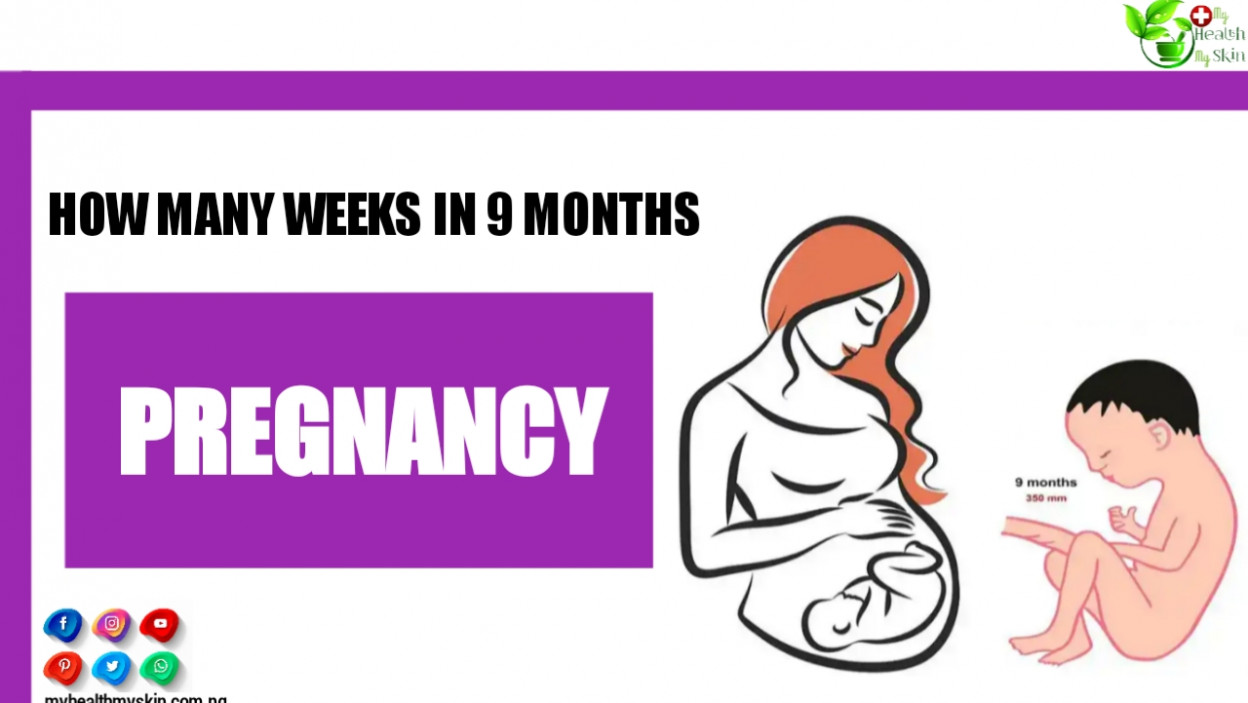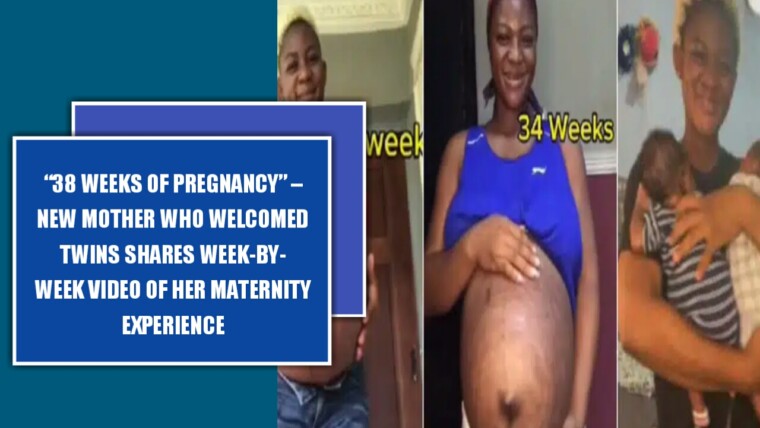At 9 weeks pregnant, the baby looks more and more human, however, the size of the head is still very large in relation to the rest of the body and the arms are bigger than the legs. The fingers and toes are practically developed, the nose and face take shape and the intestines recede into the abdominal cavity.
The placenta is practically developed and assumes most of its functions.
At 9 weeks pregnant, you still can’t identify the sex of your baby , but the genitals are already forming.
Although the size of the uterus has doubled from the original size, it is likely that you will not notice that you are pregnant but that the clothes are already getting tight. You may experience nausea and feeling sick, which tend to disappear before 16 weeks (in the 2nd trimester of pregnancy ).
Due to profound hormonal changes, emotions are running high. Sometimes you can feel contagious and full of energy, and then sad.
This wobble is perfectly natural, don’t worry! Emotional instability is very common during pregnancy and should last until your baby is born.
Keep on reading to get more information about the following topics related to Pregnancy:
- How Many Weeks In 9 Months Pregnancy: all you need to know
- How Is Pregnancy Calculated?
- The woman’s body in the 9th week of pregnancy
- What’s the timeline for fetal development?
- 9th week of pregnancy: increasingly human aspect
- Stages of growth week-by-week in pregnancy
- 1st trimester of pregnancy: 1st to 13th week
- 2nd trimester of pregnancy: 14th to 26th week
- 3rd trimester of pregnancy: 27th to 40th week
Relax, have fun and get plenty of rest. Take care of your body and enjoy the free time to date!
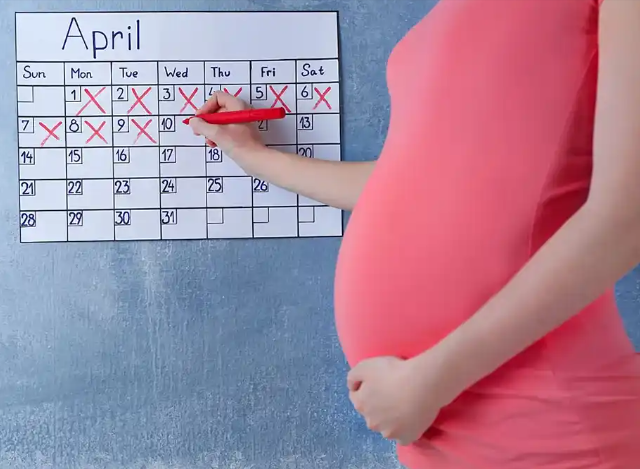
[lwptoc]
How Is Pregnancy Calculated?
Calculating the day your baby starts to develop and keeping track of your pregnancy dates can be a challenge.
The development of pregnancy is counted from the first day of the woman’s last normal menstrual period (LMP), even though the development of the fetus does not begin until conception, which is about two weeks later.
Pregnancy is calculated from this day because each time a woman has a period, her body is preparing for pregnancy. Counting from the LMP, most women are pregnant an average of 280 days.
Calculating from the LMP also gives a standard of measurement for health care providers to follow since it is extremely difficult to know exactly when conception occurred.
How Many Weeks are there In 9 Months Pregnancy?“. At MyhealthMyskin we want to answer your questions and give you the possible main changes that occur in your body in the 9th month of pregnancy and how your baby develops.
How Many Weeks In 9 Months Pregnancy?
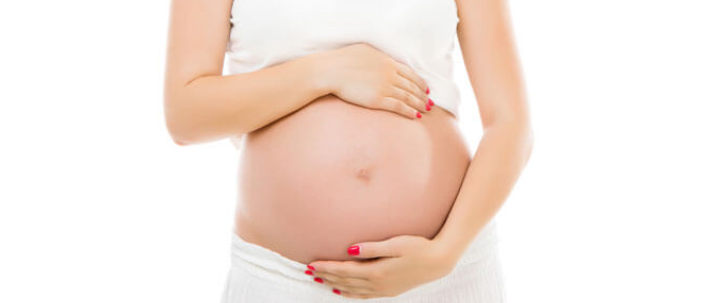
There is no simple answer, as the weeks of pregnancy don’t fit evenly within nine distinct months.
On average, a full-term pregnancy lasts 9 months. This final month could start anywhere from 33 weeks to 36 weeks and “end” somewhere around 40 weeks, more accurately 264 days from the date of fertilization of the egg, but the obstetrician will date the pregnancy from the first day of the last menstrual period (280 days or 40 weeks).
The woman’s body in the 9th week of pregnancy
The kidneys now filter a greater volume of blood (between 30 and 50%) and it is normal for you to feel the need to urinate more often, even at night when you are lying down.
The size of your uterus has doubled from its original size and it is changing position, gradually moving up into the abdominal cavity.
You may not even notice that you are pregnant. But, between this and next week, the clothes may not fit you so well and tighten, especially in the chest, belly and hips.
You may feel nauseous, make some foods sick and be more vulnerable to smells, such as your usual perfume.
Follow a proper pregnancy exercise program. Physical exercise improves the general physical condition, promotes blood circulation, relaxes the body and mind, increases muscle tone and elasticity (so important for childbirth and to help you recover your physical shape after childbirth ) and also helps to fight fatigue.
Be on the lookout for signs that could reveal some kind of complication. If you have any abnormal vaginal discharge, accompanied by burning, blood loss, cramping or severe abdominal pain, you should see your doctor immediately.
Tips And Suggestions
- If necessary, reconsider your lifestyle and avoid persisting in harmful habits that harm your baby’s healthy development (during pregnancy and breastfeeding);
- Adopt a healthy and diversified diet ;
- It is important that you get enough rest and sleep at least 8 hours a night;
- Avoid stressful situations , walk or practice other type of gentle physical exercise;
- Take care of your appearance and feel comfortable in your body.
- Avoid the use of bleaching, straightening and perms; laser treatments (such as hair removal), radiofrequency and infrared; botox or fillers; sauna and jacuzzi.
What’s The Timeline For Fetal Development?
The fetus will change a lot throughout a typical pregnancy. This time is divided into three stages, called trimesters.
Each trimester is a set of about three months. Your healthcare provider will probably talk to you about fetal development in terms of weeks. So, if you are three months pregnant, you are about 12 weeks.
You will see distinct changes in the fetus, and yourself, during each trimester.
Traditionally, we think of a pregnancy as a nine-month process. However, this isn’t always the case. A full-term pregnancy is 40 weeks, or 280 days.
Depending on what months you are pregnant during (some are shorter and some longer) and what week you deliver, you could be pregnant for either nine months or 10 months. This is completely normal and healthy.
Once you get close to the end of your pregnancy, there are several category names you might hear regarding when you go into labor. These labels divide up the last few weeks of pregnancy. They’re also used to look out for certain complications in newborns.
Babies that are born in the early term period or before may have a higher risk of breathing, hearing or learning issues than babies born a few weeks later in the full term time frame.
When you’re looking at these labels, it’s important to know how they’re written. You may see the week first (38) and then you’ll see two numbers separated by a slash mark (6/7). This stands for how many days you currently are in the gestational week. So, if you see 38 6/7, it means that you are on day 6 of your 38th week.
The last few weeks of pregnancy are divided into the following groups:
- Early term: 37 0/7 weeks through 38 6/7 weeks.
- Full term: 39 0/7 weeks through 40 6/7 weeks.
- Late term: 41 0/7 weeks through 41 6/7 weeks.
- Post term: 42 0/7 weeks and on.
Talk to your healthcare provider about any questions you may have about gestational age and due date.
Stages of Growth Week-by-Week in Pregnancy
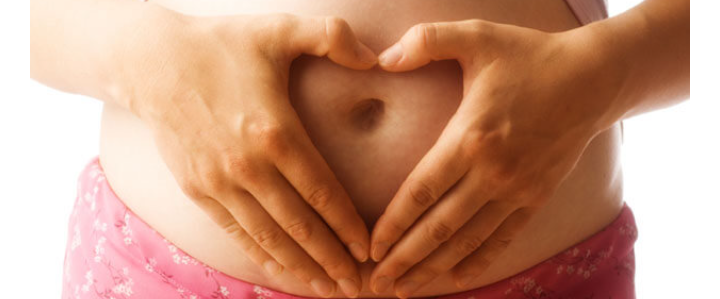
1st Trimester Of Pregnancy: 1st week To 13th Week
The first trimester of pregnancy: an egg and a sperm meet and give birth to a new life. At the end of the 1st trimester of pregnancy, your baby is a tiny human being.
How The Embryo Develops In The 1st Trimester Of Pregnancy?
In the first two weeks of pregnancy, you are not really pregnant. As it is extremely unlikely to be able to determine the exact moment when the sperm (male reproductive cell) fertilizes the egg (female reproductive cell), it was conventional to mark the beginning of pregnancy on the first day of the last menstrual period.
So when your doctor calculates your likely due date, he will count 280 days from the first day of your last period and not from the day you conceived (around day 14 of your cycle).
The Menstrual Cycle And Pregnancy
When your body starts a new menstrual cycle (usually every 28 days) it also restarts a new ovulation cycle in order to create the necessary conditions for fertilization to occur.
Fertilization
The mature egg lives between 12 to 24 hours. This is the time you have to meet a sperm and be successful in your mission. If the egg is not fertilized, it dies and is removed in the next menstrual period together with the lining of the uterine wall.
During your childbearing years, your body will repeat this process every month in the expectation of generating new life.
Of the few hundred sperm that manage to reach the fallopian tubes and force their way into the egg, only one (the strongest and fittest) manages to pierce and fertilize it.
The fertilized egg now has all the genetic information needed to generate new life. At the time of conception, the baby’s sex, physical characteristics and any hereditary health problems have already been determined.
Officially Pregnant!
At the end of the 2nd week, with conception, you are officially pregnant, although you don’t know it yet. Soon after conception, her body begins a series of changes that prepare it to welcome and nurture the developing baby.
About a day after fertilization, the egg and sperm nuclei fuse. Each parent contributes 23 pairs of chromosomes whose nucleus holds the DNA code of each parent. Chromosomes come together and form a single cell (zygote). Cell division now begins, the genesis of a new life.
The Fertilized Egg Descends Towards The Uterus
As cell division progresses, the egg begins its descent to the uterus, where it will implant, and where the baby will develop. In just 6 days, the initial cell has divided into about 200 cells and the embryo begins to break out of its protective shell. It opens and expands, attaching itself to the walls of the cervix.
By the 4th week of pregnancy, the embryo is firmly implanted in the uterine wall and is shaped like a disc (embryonic disc) measuring about 0.4 mm.
The formation of the neural tube begins in the layer of the ectoderm and the cardiovascular system, which, in a short time, will become the brain and spine of the embryo.
Embryo Development Milestones In The 1st Trimester
During the 1st trimester of pregnancy, the fetus grows at an accelerated rate and develops its own bloodstream, its main organs (heart, brain, liver, lungs and kidneys) and internal structures.
If you are pregnant with a girl, the ovaries begin to develop (when your daughter is born, she will already have a reserve of about 2 million eggs) and, if it is a boy, the testicles begin to develop, which will remain inside the abdominal cavity until the end of pregnancy, at which time they move into the scrotum.
Body And Organs In Formation
At 12 weeks pregnant, the heart is formed and working, pumping blood to all parts of the body. In the ultrasound of the 12th week, you can already hear him beating distinctly.
By the 13th week, the baby’s vital organs – liver, kidneys, intestines, brain and lungs – are fully formed and functioning (except for the lungs which still need to mature in their functions and will not function until birth).
The limbs, hands, feet and joints are well developed and fully defined. The baby already has all the organs, muscles, limbs and bones that it will be born with. The baby has fingernails on the tips of the little fingers, which are already separated, the eyes and nose are formed and are clearly distinguished from the other features of the face.
Still in this trimester, the formation of milk teeth begins. Although the ears only finish their development at the 24th week, the baby’s sense of hearing already allows him to hear sounds and vibrations from inside the mother’s body.
At the end of the 13th week, the baby measures approximately 10 cm from the crown to the feet and weighs approximately 20 g. Your baby can now yawn!
2nd Trimester Of Pregnancy: 14th week To 26th Week
The second trimester of pregnancy: the organs begin to function and the senses develop each day. Your baby between the 14th and 26th weeks of pregnancy.
How the fetus develops in the 2nd trimester of pregnancy?
Baby measures approximately 35 cm from crown to feet and weighs approximately 1000 g.
During the 2nd trimester, the baby’s growth rate accelerates. At the same time that it begins to accumulate fat, the internal organs continue their process of maturation and exercise their functions, preparing for life outside the womb.
The baby looks completely human and your baby’s facial features are practically defined and will change little until birth!
The Nervous System
The baby’s brain began to grow very quickly (growth lasting until 5 years of age). Over the next few weeks, you will start to feel your baby moving , at first very faintly, towards the end of the trimester, vigorously.
The nervous system starts to function, baby moves and puts his hands to his mouth. Reflexes are fully operational and baby trains swallowing by swallowing and expelling amniotic fluid.
Intestines And First Fecal Matter (Meconium)
The intestines can begin to produce meconium (first fecal matter produced by the baby, consisting of water, gastrointestinal secretions and other products derived from pregnancy that the baby can swallow) and the external genitals are formed.
Lanugo: The Body Is Covered With A Thin Layer Of Hair
The body progressively covers itself with lanugo (very fine hair) that protects its delicate skin from permanent contact with the aquatic environment of the amniotic fluid. The nerves are covered by a substance called myelin, which, by insulating the nerves, allows perfect coordination of limb movements.
Sleep
The baby develops its own sleep rhythm, independent of its mother’s hours of activity and rest, and sleeps and wakes up like a newborn.
At 24 Weeks, The Baby Has A Chance Of Surviving Outside The Womb.
At the 20th week ultrasound, you will be able to see your baby fully formed and moving vigorously in your womb. It is already possible to observe the sex of the baby, if he helps and is positioned in a good position!
At 24 weeks, the baby is considered viable, that is, with a chance of surviving outside the womb. Even so, he would have to be assisted in a neonatal intensive care unit.
The Organs Work
All the baby’s main organs are already functioning (except the lungs, which continue to mature their functions until birth, at which time they begin to work. Until birth, the oxygen they need is supplied through the umbilical cord and placenta).
Your lungs are not yet mature enough to fully perform their task, although the baby prepares and practices breathing, inhaling amniotic fluid: the nostrils begin to open, in the lungs, most of the airways and air pockets (alveoli) are developed and continue to produce surfactant (a liquid that acts on the pulmonary alveoli and ensures the necessary elasticity for respiratory function).
Primary Reflexes
The sucking reflex is established and the permanent teeth are lodged inside the gums (these will only descend around 6 years of age, replacing the primary teeth).
The eyelashes (eyelashes), eyebrows and eyes, which the baby opens and closes, are fully formed and sensitive to light.
The Senses Develop
The brain continues to improve brainwave activity for the visual and auditory systems. The bones in the middle ear (inner ear) continue to harden, making sound conduction possible.
The baby recognizes the sounds produced by the mother’s body, such as breathing, heartbeat and voice, moves to the rhythm of the music and the heartbeat reacts to external auditory stimuli, accelerating.
Curiosities
If your baby is a girl, the ovaries already contain the primary oocytes (at birth, your daughter will have about 500,000 primary oocytes that gradually die, reaching 30,000 at puberty) and the uterus is fully formed.
In boys, the testes begin to descend from the pelvis to the scrotum and already contain the first immature sperm.
3rd Trimester Of Pregnancy: 27th week To 40th Week
3rd trimester of pregnancy: the first hairs appear, fattening and getting ready to be born. How your baby develops between the 27th and 40th week of pregnancy.
How The Fetus Develops In The 3rd Trimester Of Pregnancy?
During the 3rd trimester, the baby prepares to be born. As you gain weight, your baby’s body becomes rounder and the skin becomes tighter. At birth, the skin appears pink and soft and the soles of the hands and feet are wrinkled.
The brain continues to develop as the neuronal connections become more complex: it already controls breathing and body temperature and the baby behaves like a newborn, showing more than 70 different reflexes (closes eyes when sleeping and opens -os when it is active, can distinguish sweet from acid and reacts to pain like a newborn, for example).
The Body Becomes Proportionate To The Head
The organs continue to grow, following the general growth of the baby’s body and the size of the head is increasingly proportional to the body. The senses are heightened. The baby becomes sensitive to light, noise, taste and smells.
Baby Turns Upside Down Preparing To Be Born
With the lack of space in the uterus, the baby bends his legs, which are curled up on themselves (fetal position) increasing the pressure on the mother’s pelvic area. The baby will be able to change position, turning upside down towards the pelvis.
The iris becomes colored (the final color only appears between 6 to 9 months of age, after exposing the eyes to natural light) and the pupils react to light, being able to distinguish natural from artificial light through the wall uterine.
The intestines accumulate a considerable amount of meconium (first fecal matter produced by the baby) which is usually eliminated soon after birth.
Immunity System
The baby’s immune system will continue to develop after birth. In the early days, your baby’s natural defenses will be strengthened with breastfeeding due to the compounds that it transmits through breast milk.
At birth, a baby has 270 bones, decreasing to 206 in adulthood as some of them fuse together to form a single bone structure.
The Bones Of The Skull Are Flexible To Facilitate The Exit Of The Head In Childbirth
The skull is not yet completely solid, which will make it easier for the baby’s head to pass through the birth canal. As the 5 fontanelles (the soft, membranous space that separates the bones of the skull) are still soft and separate, it is possible to press against each other during birth, stretching the baby’s head. After delivery, the head returns to its natural shape.
The lungs are fully developed and increase surfactant production to keep the alveoli open which facilitates the breathing process.
Baby Is Ready To Be Born
At 37 weeks, the baby is considered a full-term baby and can be born at any time. All baby systems are fully developed and ready for the next step.
The heart beats at a rate of 110 – 150 beats per minute. When you breathe in for the first time, blood will flow through your lungs and your baby will become an autonomous human being, capable of ensuring all vital functions by itself!
Baby measures approximately 50 cm from crown to feet and weighs approximately 3250 g.
If you want to read more articles similar to, How Many Weeks In 9 Months Pregnancy? we recommend you visit our Women’s Health category.
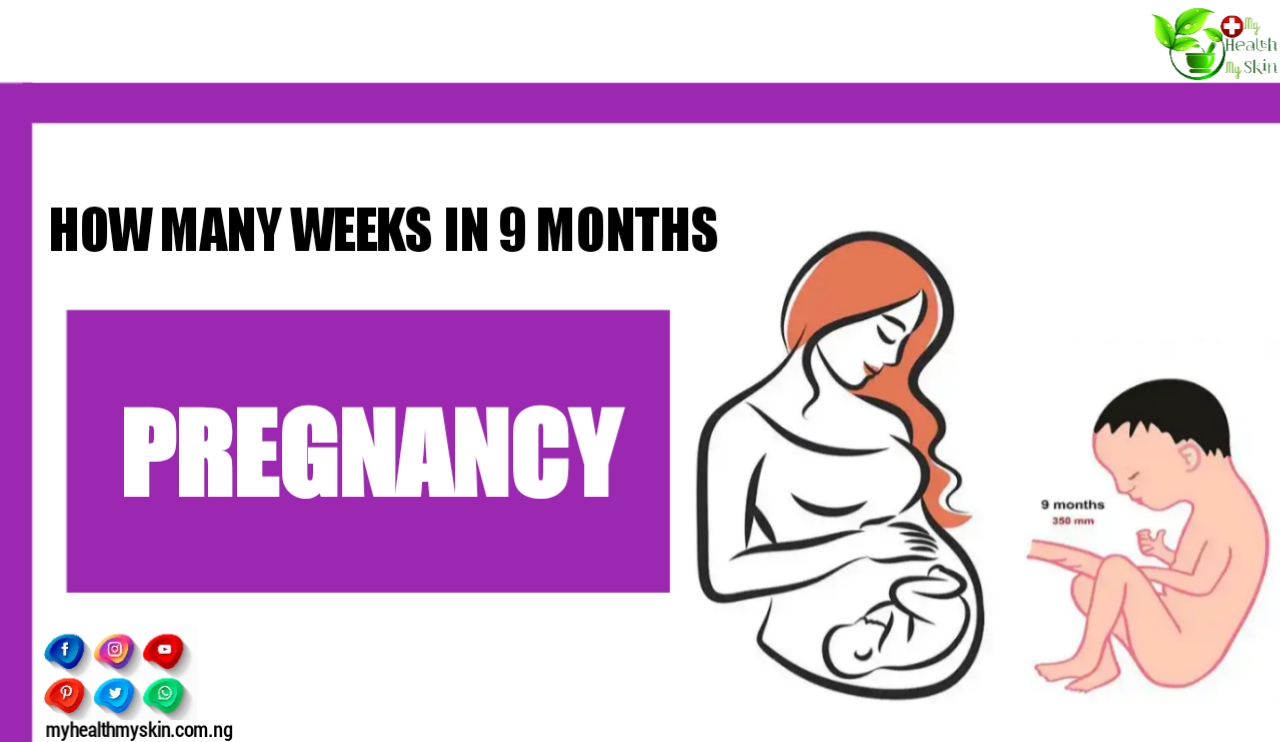
Now That You Know The Weeks In 9 Months Pregnancy (1st Trimester Of Pregnancy: 1st To 13th Week, 2nd Trimester Of Pregnancy: 14th To 26th Week, 3rd Trimester Of Pregnancy: 27th To 40th Week), Hope You Find This Article Helpful? Comment Below!

